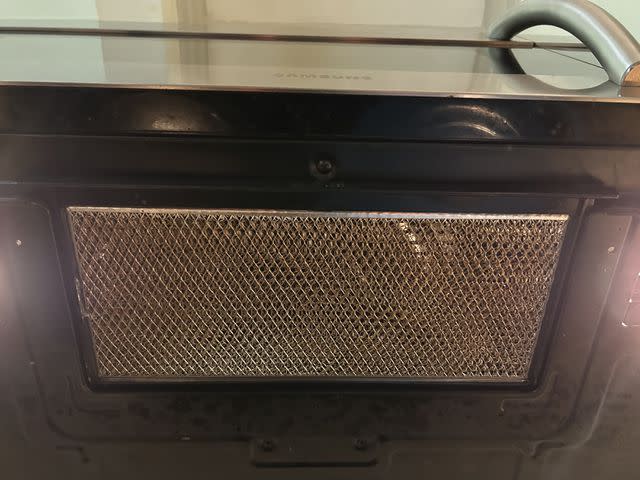You Probably Need To Clean Your Microwave Filter—Here's How
Remove grease and debris to ensure optimal performance and longevity of your microwave.

Getty Images / Jason Finn
Fun fact: Similar to the lint trap in your dryer, or the filter in your air conditioner, your microwave also has a filter that needs to be cleaned out, too. Some folks might not know about microwave filters, especially because not all microwaves actually have one. You’ll find grease filters on most over-the-range microwaves, rather than countertop microwaves.
If you have an over-the-range microwave, you need to make sure you’re cleaning out the grease filter regularly. Below, we’ve inquired with the experts to find out how to properly clean a microwave filter, when should it be replaced, how often to clean them, and much more.
Meet The Expert
Yooshin Kim is Senior Manager of Quality Engineering at LG Electronics.
Jacqueline Stein is a professional cleaner and the owner of Home Reimagined in Austin, Texas.
Sara San Angelo is a professional home cleaner and founder of Confessions of a Cleaning Lady in Charleston, South Carolina.
Before Getting Started
Grease filters are used to catch grease from your stove and filter the air in your kitchen. They can be found on the bottom side of over-the-range microwaves. According to Yooshin Kim, a Sr. Manager of Quality Engineering at LG Electronics, it’s important to clean microwave filters because dirty and clogged grease filters will limit airflow to internal electronic components and can also cause the exhaust vent to perform poorly. “A dirty recirculation filter can impact venting performance, including any odor-reducing properties,” he explains.
The microwave filter is crucial for protecting your microwave's internal parts from gunk getting stuck or the fans from overheating. “Plus, it’s part of what keeps those stinky odors from the microwave (and oftentimes the stove below it) from lingering in your home,” explains Jacqueline Stein, a professional cleaner and the owner of Home Reimagined in Austin, Texas.
Before cleaning your microwave filters, you always want to make sure that your microwave is unplugged. Additionally, it might be a good idea to wear rubber gloves if you plan on using any abrasive or strong cleaning products.
Related: 8 Household Items You Probably Aren't Cleaning Often Enough, According To Experts
What You’ll Need
Hot water
Dish soap
Soft brush or sponge
Bowl or sink

Southern Living
How To Clean a Microwave Filter
Identify which type of grease filter you have—there are two types. The first type is a grease filter that’s made of metal—typically aluminum. These types of grease filters can be washed. The other type of grease filter is made with charcoal, and these cannot be washed—you must replace them on your over-the-range microwave.
Locate the filters on your microwave. The location may vary by brand, so check your manual or search the model online. “Most over-the-range microwaves have their grease filters underneath them on the bottom (there are often one to three of them),” explains Stein.
Remove the filter from the microwave. Most slide or pop out fairly easily—you will likely not need tools.
Shake out filters or tap on the side of the trash can to remove any large particles that may have stuck to the filters.
Fill a bowl or the sink with warm or hot water and about a tablespoon of dish soap, suggests Stein.
Drop the filters into the soapy water and soak them for 15-30 minutes to easily lift and loosen grease and gunk.
Once soaked, use a soft sponge or a non-wired brush (soft-bristled is best) to gently scrub the filters. “Be careful not to scrub or press too hard on the mesh, otherwise this can damage the filters,” warns Stein. “Using gentle sponges, brushes, or cloths is best to avoid damage.”
Rinse the filters well under the sink.
Set aside to air dry fully, before reinserting into the microwave.
How To Tell If Your Filter Should Be Replaced
Signs that your microwave filter should be replaced include visible damage, such as cracks or breaks in the mesh or siding, a significant buildup of grease or dirt that cannot be cleaned off, or if the filter no longer fits securely in place. “Pay attention to it and check it often to ensure it is still in good, working order,” says Stein.
Other ways to tell if you need to replace your microwave filter is if you notice that the exhaust vent is not performing as well as it used to, or if the filter is looking yellow or brown from built-up grease and gunk, explains Kim.
How Often Should I Clean My Microwave Filter?
According to Sara San Angelo, a professional home cleaner and founder of Confessions of a Cleaning Lady in Charleston, South Carolina, this will really depend on how often you use the fan feature of the microwave and cook on your stovetop. “If you do this often, you may want to clean the filters once a week,” she suggests.
Additionally, what you’re actually cooking will determine how often you clean the filters. “Extracting water vapors or steam will have less of an impact on the microwave than extracting grease vapors,” explains Kim. If you don’t use the over-the-range grease filters often, or don’t cook a lot of food that produces grease, Stein says that you can clean the microwave filters every three to six months.
Signs of a Dirty Microwave Filter
According to San Angelo, some signs of a dirty microwave filter include if they are discolored, sticky, and/or sometimes smell like grease. You will often know it is time to clean the filter when a faint or foul odor is coming from your microwave. “Other signs include the microwave not heating food evenly or well, visible build-up on the filter, or even labored-seeming fan ventilation on your microwave,” says Stein.
Frequently Asked Questions
Can I use a dishwasher to clean the microwave filter?
Most microwave filters (and most filters of other appliances and tools) are not dishwasher safe. “The dishwasher is too abrasive for more filters and can easily cause damage to the filters,” says Stein. “For best results, I always recommend cleaning your filters by hand—and always consult your appliance’s manual to see the recommended cleaning method.”
Are there any alternative cleaning methods for microwave filters?
An alternative method is to use a degreasing cleaner specifically designed for kitchen appliances. Spray the cleaner onto the filter, let it sit for a few minutes to loosen the dirt and grease, then rinse thoroughly with water. “Before doing this though, always consult the manual with the manufacturer's instructions to ensure compatibility with your filter,” warns Stein. ‘Many filters will not hold up well to abrasive or tough cleaners like these, so always proceed with caution and see instructions first.”
Related: 3 Easy And Effective Ways To Clean Your Microwave To Remove Stains And Odors
For more Southern Living news, make sure to sign up for our newsletter!
Read the original article on Southern Living.

